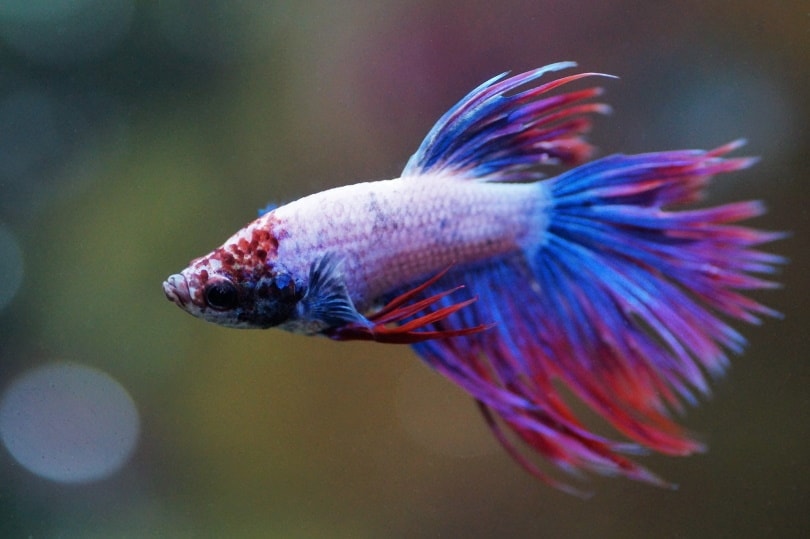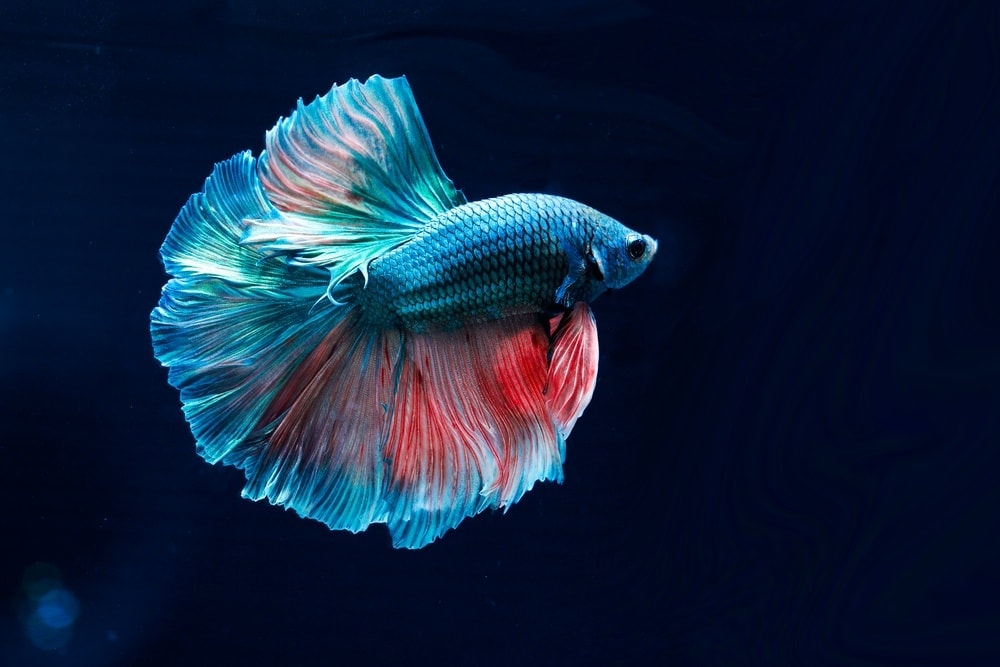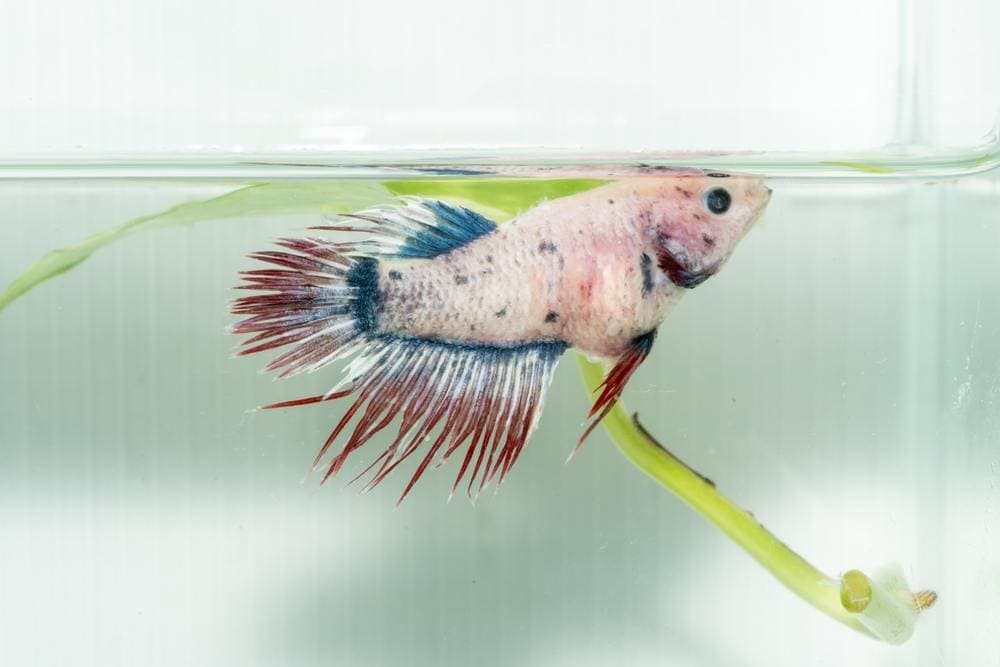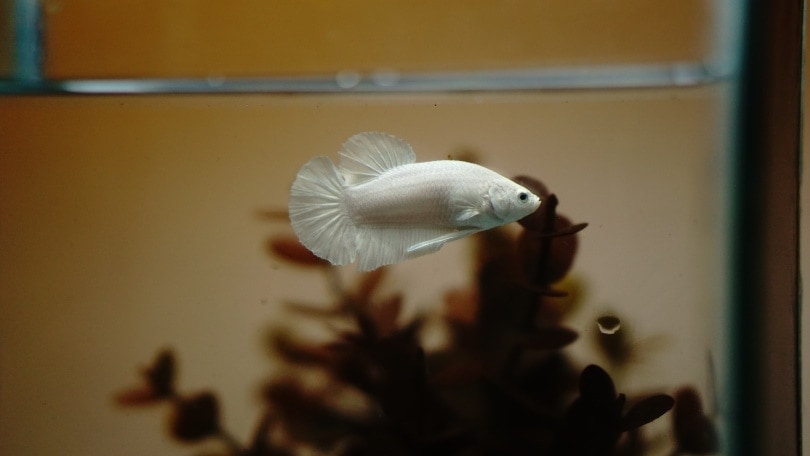How to Treat Betta Fish Swim Bladder Disease or Disorder (SBD)

Updated on

Many beginner fish keepers have felt the shock of approaching their aquarium, only to see one of their fish floating upside down or swimming sideways. Your first reaction might be to think your fish is dead or getting close to it, but on closer inspection, you’ll hopefully see this isn’t the case.
Anyone who’s seen it before will know what’s going on: Betta fish swim bladder disease. While it sounds serious, swim bladder disease—or SBD—is extremely common in betta fish and, in many cases, is easily remedied.
This article will cover all you need to know about betta swim bladder disease, what to do if it happens to your fish, and how to prevent it.
What is Swim Bladder Disease?
Despite the name, it isn’t actually a disease. More accurately, it’s a generic term for a range of issues with the swim bladder of a fish. Often, it’s a symptom of an underlying condition, rather than a standalone problem.
To understand the issue, you first need to know more about the swim bladder.
Betta, along with most other bony fish, have a gas-filled organ inside them called a swim bladder. Its purpose is to control a fish’s level of buoyancy, allowing them to easily move up and down in the water, staying afloat wherever they are.
However, when a betta has SBD, the organ is malfunctioning, so the fish is no longer able to easily move around in their tank.

What are the Signs of Betta Fish Swim Bladder Disease?
If you notice any of these signs, your betta probably has SBD.
- Your betta fish swimming upside down
- Floating right at the top of the tank
- Sinking to the bottom of the tank
- Swimming upside down
- Developing an S-shaped spine
What Causes Swim Bladder Disease in Betta?
There are a number of causes of SBD in betta. Let’s look at the most common.
- Constipation: This is the most common cause. Not soaking dry pellets and freeze-dried food can be the culprit as they expand within the stomach.
- Overfeeding: Most people will identify with feeling exceptionally bloated after a heavy meal, but for betta, this can cause issues with their swim bladder.
- Injury: A betta that has suffered an injury could have damaged their swim bladder.
- Bacterial infection: Some types of bacterial infection can cause SBD.
- Birth defect: Some betta with swim bladder problems are just born that way.
- Poor water quality: High nitrate levels have been known to lead to swim bladder disorder.

Can Swim Bladder Disorder Spread?
Swim bladder disorder itself is not contagious, but the cause of it can be. If the SBD is caused by a bacterial infection or parasites, then this can spread to other fish. If it’s due to constipation or a genetic disorder, then no it cannot.
In all cases, swift treatment is recommended, despite what the cause may be.
How Can You Identify the Cause of Your Betta’s SBD?
To treat swim bladder disorder, you first need to know what’s causing it and it can be tough to identify, sometimes requiring a bit of trial and error. That said, we do have some tips to help you uncover the underlying cause. First of all, you must make sure your overall care of your betta is up to scratch, then work through the following checks.
The most common cause of swim bladder disorder in betta is constipation. If they are suffering from this, they’ll look fairly healthy overall, but you’ll notice a lack of defecation and a bloated stomach.
The signs of overfeeding are similar to the symptoms of constipation, so it can be tough to tell the two apart. And, constipation may be caused by overfeeding, anyway, so the two are linked. If the SBD is down to an injury, you’ll likely see some external damage. Signs to look out for that would indicate a bacterial infection include dull coloring, general lethargy and a refusal to eat.
If poor water quality is the cause, then it’s important to do a water change to remove the chemicals from the water, then establish a good water care routine going forward, including frequent use of a water parameter test kit and frequent partial water changes.
Finally, if a birth defect is the cause, it’s likely that your betta will have always had this issue, so if you’ve ever known them to swim normally, it’s probably not a birth defect.

Is Swim Bladder Disease Fatal?
Generally speaking, it’s not fatal, no. But it certainly can be, particularly if left untreated.
The main thing to keep in mind is that SBD is usually an outward sign of another issue affecting your fish, from digestive issues, to bacterial infection. The underlying cause must be treated, otherwise it can lead to fatality.
However, very often it can be cured.
Do Bettas Recover From Swim Bladder Disorder?
Sadly, SBD is a very common ailment in betta fish. Luckily, it’s rarely fatal. Most commonly, SBD is due to digestive problems, constipation being the main culprit. If this turns out to be the cause, then it’s very easily treatable as we shall discuss below.
If, however, the SBD is due to a bacterial infection, is genetic in nature, or due to permanent damage to the swim bladder, then it can be permanent I’m afraid. However, even in these cases, it’s not common to be fatal, and many fish can still live long lives with some degree of SBD.
How Do You Treat Swim Bladder Disease in Betta Fish?
No matter the cause, the first thing to do for swim bladder treatment—if possible—is to move them to a smaller hospital tank.
It should be adequately heated, filtered, and treated like your main aquarium, but with a bare bottom. This helps to remove any potential environmental issues in your main tank but also helps confine your betta, so they don’t get exhausted trying to swim too much.
Once in the hospital tank, you should treat your betta according to what’s causing their SBD. If you’re unsure of the cause, start at the top of the list and work your way down.

Constipation
The first step to treating constipation is to fast your fish for 1 to 3 days. This means no feeding at all. Often the blockage will clear out on its own, and the swim bladder disorder will disappear.
If your fish still hasn’t righted themselves in the water after their fast, try feeding either a small portion of daphnia—which acts as a laxative—or a quarter of a blanched, frozen pea, which is mostly indigestible to a betta fish and may help to clear their system out. Feeding boiled, shelled peas is a well-known and common way to clear constipation in many fish.
There’s also some evidence to suggest Epsom salts can help. Add one tablespoon of Epsom salts to the aquarium for every 5 gallons of water.
Overfeeding
The only way to cure swim bladder disorder caused by overfeeding is to fast your betta until they start swimming normally again, but for no more than three days. If caused by overfeeding, it will often go away in just a few hours.
If you’ve fasted them for 3 days and they still aren’t back to normal, overfeeding probably isn’t the cause.

Bacterial Infection
If suffering from a bacterial infection, they will need to be medicated with antibiotics. Try treatments like Seachem Kanaplex or API Sulfa for an external infection. For an internal infection, you’ll need medicated food or to soak your betta’s food in medication yourself.
Remember to remove any carbon filters from your aquarium before medicating, as they’ll filter out the medication. If in doubt about how to treat bacterial infections, consult a veterinarian with expertise in pet fish, or failing that a knowledgeable staff member at a reputable local fish store.
Injury
Sometimes swim bladder disorder caused by an injury will get better with time, but sometimes the damage will sadly be permanent. The good news is that SBD isn’t painful or fatal on its own, so you can make modifications to keep your fish happy. More on that below!
Birth Defect
There’s no cure for a swim bladder issue caused by a birth defect. However, like an injured betta, it’s possible to keep them happy in a suitable environment.
How Can You Care for a Betta with Chronic SBD?

Just because a betta has chronic swim bladder disease due to an injury or birth defect, it doesn’t mean they can’t live a full and happy life, it just means you must tailor their environment to fit their needs. A wide, shallow tank is best as they don’t have to do so much work to swim to the top for air, or to the bottom for any food that may have settled there.
It’s also advisable to place live or silk plants with wide, flat leaves in their tank, as they can rest on them when necessary. You can also buy “betta hammocks” which serve the same purpose.
Is There a Way to Prevent Swim Bladder Disease?
There’s no 100% effective way of preventing it, but there are several things you can do that will significantly decrease the chances of having issues.
- Never overfeed and ideally feed two smaller meals a day rather than a single larger one.
- Don’t feed freeze-dried foods or dried pellets unless you soak them in a little tank water before feeding, as they’ll expand in this time instead of expanding in the stomach.
- If you need to net or handle your betta, be extremely gentle to avoid injury.
- Make sure the tank contains clean water with appropriate filtration and cycling in place.
- Keep an eye on water parameters and temperature.
Conclusion
Swim bladder disease might look serious, but in most cases, it’s nothing more than the result of your betta overeating. That said, it certainly shouldn’t be ignored, because she can be a sign of something more serious.
This post has given you all the information you need to treat and prevent betta swim bladder disease, so now you’ll know what to do should you start to see the signs.
Featured Image Credit by: ivabalk, Pixabay












